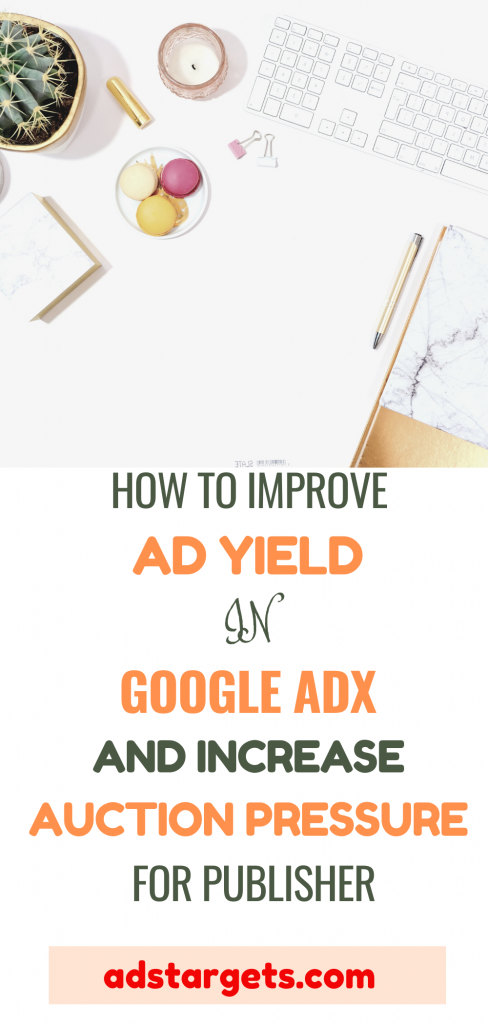Most publishers aim for higher earnings from Google AdX. However, only a handful of them actually try or implement methods that lead to improved Ad yield in Google AdX and also increase their auction pressure.
Auctions generally are designed in a way that the highest bidder is offered the product. In the real world of Ad bidding, the seller (publisher) usually sets the initial price while bidders (buyers) are allowed to bid for the product that is put up for sale.
What comes next is buyers are given the opportunity to propose higher prices and, usually, the price at which the product is sold is higher than the real value of the inventory.
In the case of programmatic advertising, things are a bit different and the auctioning in the case of second-price auctions are organized differently.
But to get things more clear here… Let’s first explain what Second price action is…
In cases like this, bidders set the price that they are willing to pay for per CPM (1,000 impressions). However, they end up paying a different amount than their initial proposal and rather they are allowed to pay slightly higher than the second-highest bidder which in most cases they pay $0.01 more than the second-highest bidder.
But still, the price they bid is rarely the exact amount they pay, since the winning bidder pays only $0.01 more than the second-highest bidder. Now, let me show how it works on numbers below.
Here is an example showing 4 bidders bidding for Ad impressions
- Bidder A bids $1.5
- Bidder B bids $2.5
- Bidder C bids for $5
- Bidder D bids for $4
As you can see in the image, the winner has to pay only $4.01 even though he bids for $5. Using the second price auction system, the winner has to pay only an additional $0.01 in addition to the amount proposed by the second-highest bidder at the end of the bidding section.

Regardless of the form of auction, publishers are constantly trying to increase their revenues, this is one of the reasons why Google Adx is created to help publishers by using either floor price optimization, or auction pressure increase.
Table of Contents
ToggleWhat is Auction Pressure?
Auction pressure is simply can be said to be a process of enhancing of auction competition between media buyers. Auction pressure is used to stimulate media buyers to offer higher prices to the inventory they intend to buy.
In cases where the competition is high during an auction, it results in the following:
- CPM and BID Value: This is a clear example of demand and supply. When you have a lot of buyers bidding for inventories, It results in higher CPM and Bid value increases.
- Fill rate: Having more buyers participating in the auction results in more bids which end up reducing the stock of unsold inventory and rather increase the fill rate for publishers.
- Ad Revenue: Another plus for publishers, when there is auction pressure, is that Their earnings also increase as media buyers are willing to pay more to acquire their inventory.
The question of whether ad pressure benefit publishers or not can be clearly answered that it does favor them in many ways period.
So let’s look at how you can actually increase your Auction Pressure and Improve Ad Yield in Google AdX.
How to Increase Auction Pressure in Google AdX
One of the most effective ways of increasing Ad pressure is to get more buyers to compete for the available inventory within the Google AdX. This requires publishers to do away with some of the restrictions they place within the system which will make more buyers qualified to bid for their inventory.
Here are some of the tips that will increase your performance in Google AdX on your publishing website or blog.

1. Remove category blocking
In the quest for publishing only quality and relevant ads, some publishers put a lot of restrictions on some categories which limit some ads showing on their blogs and sites.
This is not always good as it leads to a low number of Ads in the auction. This affects the fill rate and revenues of those publishers.
It causes the CPM for the winning ads to be lower because every blocked category leads to decrease in ads number and respectively of competitiveness.
The advice here is to removed those blocked categories to the status of unblocked to increase the competitiveness among media buyers.
So, here are the steps to unblock those categories.
- First, In-Ad Exchange, choose the Rules Tab and click Blocking in the menu; It will display all the blocked categories for each rule.
- Second, you can unblock a category by clicking X next to the name of the category;
- Third, assign rules for more categories that will enable more ads to be shown on your site or blog.
2. Do away with Advertisers URL Blocks
Hence publishers are given the opportunity to block some Advertisers URLs, publishers do often block just too many of the advertisers URLs because they want only quality ads to appear on sites, the negative effect of this is that it results in less auction competition.
If you have blocked too many advertisers URLs, please consider unblocking some of them to increase competitiveness.
Here are the steps to remove the blocked advertiser URLs:
- Select the Rules tab in Ad Exchange and hit Blocking in the Navigation menu. For each rule you can see a list of each blocked advertiser URL;
- To unblock the advertiser, Click delete to unblock the advertiser;
- Move the block from Everything to specific rules to be able to display inventory at less restricted sites.
3. Enable Branding
Majority of media buyers opt for branded inventory because it is known to be premium. As a publisher, this should rather be an opportunity for you to increase your CPMs in the Google AdX.
Consider enabling branded inventory and follow the updated in the reporting section where publishers are updated on how Ads are performing as branded content.
Here are steps to enable branding in Google AdX.
- Select the Rules tab;
- Press Edit;
- Activate Branded under the menu;
- Set a minimum price;
- Click Save.
- Repeat the same steps for each rule.
4. Use Responsive Ad Type
With the recent Google Adsense updates, one Ad type (Responsive) Ad types make it easy for publishers to publish all Ad types using one snippet Code. With this responsive Ad type, your ads will be able to adjust automatically to the required sizes and shapes.
Previously, you will have to set rules such as allowing images and text at the same point. This procedure is still on and you can also use in case you do not choose to use responsive code.
Using images and text to date also has a significant impact on your revenue as it improves your match on your site and also increases your fill and Ad yield which results to eCPM and consequently increase auction pressure.
Enabling both text and photo advertising to bid for your ad stock creates auction pressure, likely resulting in the price and eCPM increase.
Another thing you should have in mind is that creating line items in different sizes also can help increase your Ad yield and revenue. This is because some of those line items have different ad sizes and their prices vary as set by advertisers.
Here are the steps:
- In Ad Exchange, click Rules, and then Ad Styles & Backup Ads. You can see which type of ad is allowed under “Ad Styles.“
- To allow text and display ads, click Edit and choose Image / Rich Media Ads and Text Ads under Ad Types.
5. Allow Third-party vendors Opt-in
In order to prevent unwanted vendors from operating on your platform, Ad Exchange allows publishers to decide and Opt-in ad technologies if they choose to.
The fact is, many media buyers use various third-party vendors and their technology tools for buying media, remarketing and data collection which needs to be certified by Google before they are allowed into the system.
This is to tell you to trust them too since Google has given them access to your inventory. Allowing those ad technologies will increase the demand flowing through the network which will benefit publishers.
Follow these steps to Opt-in Ad Technologies:
- Click Rules, then Opt-In;
- Allow as many ad technologies as you feel comfortable running through your account in the Everyone rule.
Conclusion
As a publisher, monetising your traffic to get the maximum income benefit should be a top priority. Using Google Ad Exchange could be one of the greatest opportunities.
Though there is a lot involved in optimising your Ad display to improve your fill rate, eCPM and ultimately revenue can be possible in the above suggestions.
It is enormous opportunities also using tools like Google DFP to optimise Ad positions and sizes from various demand sources.
Maximising your revenue should be your focus but that does that mean you will allow all kind of Ads to be published on your site or blog is it’s against your principles. We advise you to carefully review these suggestions before implementing them on your publishing sources.








